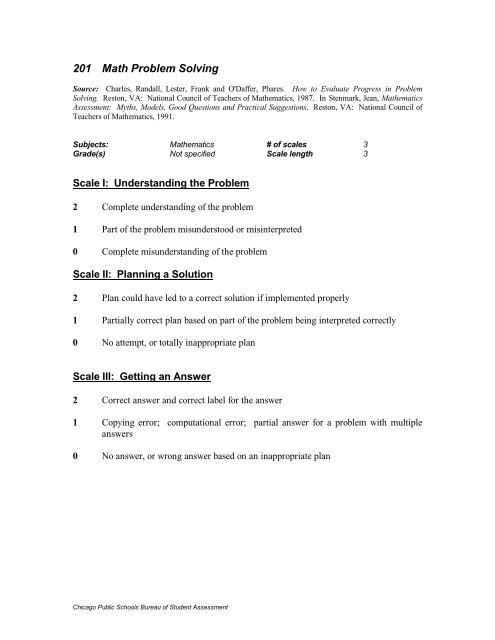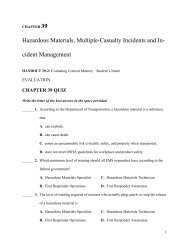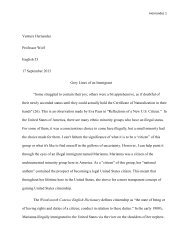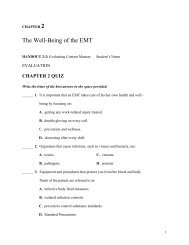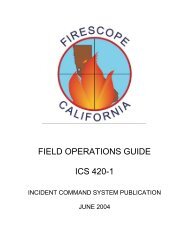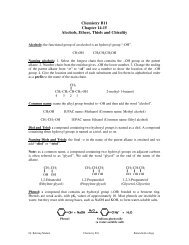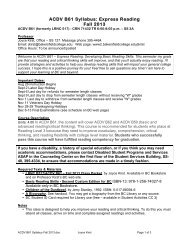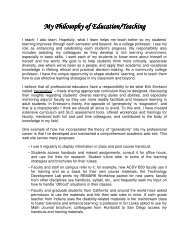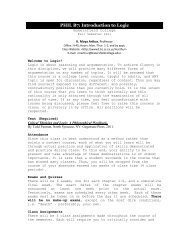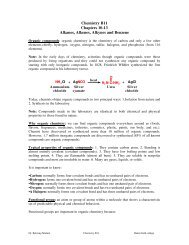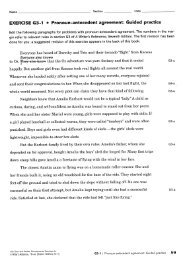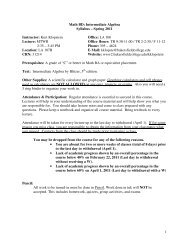Other Math Rubrics - Njit
Other Math Rubrics - Njit
Other Math Rubrics - Njit
- No tags were found...
Create successful ePaper yourself
Turn your PDF publications into a flip-book with our unique Google optimized e-Paper software.
201 <strong>Math</strong> Problem SolvingSource: Charles, Randall, Lester, Frank and O'Daffer, Phares. How to Evaluate Progress in ProblemSolving. Reston, VA: National Council of Teachers of <strong>Math</strong>ematics, 1987. In Stenmark, Jean, <strong>Math</strong>ematicsAssessment: Myths, Models, Good Questions and Practical Suggestions. Reston, VA: National Council ofTeachers of <strong>Math</strong>ematics, 1991.Subjects: <strong>Math</strong>ematics # of scales 3Grade(s) Not specified Scale length 3Scale I: Understanding the Problem2 Complete understanding of the problem1 Part of the problem misunderstood or misinterpreted0 Complete misunderstanding of the problemScale II: Planning a Solution2 Plan could have led to a correct solution if implemented properly1 Partially correct plan based on part of the problem being interpreted correctly0 No attempt, or totally inappropriate planScale III: Getting an Answer2 Correct answer and correct label for the answer1 Copying error; computational error; partial answer for a problem with multipleanswers0 No answer, or wrong answer based on an inappropriate planChicago Public Schools Bureau of Student Assessment
202 California Generalized Rubric for <strong>Math</strong>Source: California State Department of Education, A Question of Thinking. Sacramento, CA: CaliforniaState Department of Education, 1989Subjects: <strong>Math</strong>ematics # of scales 1Grade(s) Not specified Scale length 6Holistic Scale6 Exemplary response. Gives a complete response with a clear, coherent,unambiguous and elegant explanation; includes a clear and simplified diagram;communicates effectively to the identified audience; shows understanding of theopen-ended problem's mathematical ideas and processes; identifies all the importantelements of the problem; may include examples and counterexamples; presentsstrong supporting arguments.5 Competent response. Gives a fairly complete response with reasonably clearexplanations; may include an appropriate diagram; communicates effectively to theidentified audience; shows understanding of the problem's mathematical ideas andprocesses; identifies the most important elements of the problem; presents solidsupporting arguments.4 Minor Flaws But Satisfactory. Completes the problem satisfactorily, but theexplanation may be muddled; argumentation may be incomplete; diagram may beinappropriate or unclear; understands the underlying mathematical ideas; usesmathematical ideas effectively.3 Serious Flaws But Nearly Satisfactory. Begins the problem appropriately but mayfail to complete or may omit significant parts of the problem; may fail to show fullunderstanding of mathematical ideas and processes; may make majorcomputational errors; may misuse or fail to use mathematical terms; response mayreflect an inappropriate strategy for solving the problem.2 Begins, But Fails to Complete Problem. Explanation is not understandable;diagram may be unclear; shows no understanding of the problem situation; maymake major computational errors.1 Unable to Begin Effectively. Words do not reflect the problem; drawingsmisrepresent the problem situation; copies parts of the problem but withoutattempting a solution; fails to indicate which information is appropriate to theproblem.Chicago Public Schools Bureau of Student Assessment
203 Analytical Scale for Problem SolvingSource: Szetela, Walter and Nicol, Cynthia. Evaluating Problem Solving in <strong>Math</strong>ematics. EducationalLeadership, May 1992, pp. 42-45.Subjects: <strong>Math</strong>ematics # of scales 3Grade(s) Not specified Scale length 3-5Scale I: Understanding the Problem4 Complete understanding of the problem3 Misinterprets minor part of the problem2 Misinterprets major part of the problem1 Completely misinterprets the problem0 No attemptScale II: Solving the Problem4 A plan that could lead to a correct solution with no arithmetic errors3 Substantially correct procedure with minor omission or procedural error2 Partially correct procedure but with major fault1 Totally inappropriate plan0 No attemptScale III: Answering the Problem2 Correct solution1 Copying error; computational error, partial answer for problem with multipleanswers; no answer statement; answer labeled incorrectly0 No answer or wrong answer based upon an inappropriate planNote: This rubric is based on rubric 201.Chicago Public Schools Bureau of Student Assessment
204 North Carolina <strong>Math</strong> Rubric ISource: North Carolina Department of Public InstructionSubjects: <strong>Math</strong>ematics # of scales 1Grade(s) Elementary Scale length 4Holistic Scale3 All parts of the question are answered accurately and completely. All directions arefollowed.2 Answer deals correctly with most aspects of the question, but something is missing.May deal with all aspects but have minor errors.1 Addresses item but only partially correct; something correct related to the question.0 Does not address task, unresponsive, unrelated or inappropriate. Nothing correct.Chicago Public Schools Bureau of Student Assessment
205 North Carolina <strong>Math</strong> Rubric IISource: North Carolina Department of Public InstructionSubjects: <strong>Math</strong>ematics # of scales 1Grade(s) Elementary Scale length 53Holistic Scale2 Answer is complete and correct; all parts of the question are addressed.1 Student gives a partially correct answer, or task is incomplete (i.e., one of two partsanswered correctly.0 Does not address task, unresponsive, unrelated or inappropriate.Chicago Public Schools Bureau of Student Assessment
206 Maine Holistic Rubric for <strong>Math</strong>ematics Open-Ended ItemsSource: Maine Department of EducationSubjects: <strong>Math</strong>ematics # of scales 1Grade(s) Not specified Scale length 5Holistic Scale4 A correct solution and an appropriate strategy are shown or explained and thesolution is shown with correct label or description if necessary.3 A complete, appropriate strategy is show or explained but:• an incorrect solution is given due to a simple computational or other error or• no solution is given.A correct solution is given with no solution strategy or explanation shown.A correct solution and appropriate strategy is shown or explained, but not labeledcorrectly when necessary.2 Some parts of an appropriate strategy are shown or explained, but some keyelements are missing.Some parts of an appropriate strategy are shown or explained, along with someinappropriate parts.Appropriate strategy shown or explained, but implemented incorrectly.1 Some work or explanation beyond re-copying data, but work would not lead to acorrect solution.One or more incorrect approaches attempted or explained.0 No work or solution shown or explained.Incorrect solution and no work shown or explained.Some data from the problem copied over, but no evidence of any strategy is shownor explained.Chicago Public Schools Bureau of Student Assessment
207 Vermont <strong>Math</strong> Problem Solving CriteriaSource: Vermont Department of EducationSubjects: <strong>Math</strong>ematics # of scales 4Grade(s) 8 Scale length 4Scale I: Understanding the Problem4 Identified special factors that influenced the approach before starting the problem.3 Understood the problem.2 Understood enough to solve part of the problem or to get part of the solution.1 Didn't understand enough to get started or make progress.Scale II: How Student Solved Problem4 Approach was efficient or sophisticated.3 Approach would work for the problem.2 Approach would only lead to solving part of the problem.1 Approach didn't work.Scale III: Decisions Along the Way4 Clearly explained the reasons for the correct decisions made throughout theproblem.3 Didn't clearly explain the reasons for decisions, but work suggests correct reasoningused for only part of the problem.2 Only partly correct reasoning, or correct reasoning used for only part of theproblem.1 No reasoning is evident from the work or reasoning is incorrect.Scale IV: Outcomes of Activities4 Solved the problem and made general rule about the solution or extended thesolution to a more complicated situation.3 Solved the problem and connected the solution to other math or described a use forwhat was learned in the "real world."2 Only partly correct reasoning, or correct reasoning used for only part of theproblem.1 Solved the problem and stopped.Chicago Public Schools Bureau of Student Assessment
208 QUASAR General Rubric (page 1 of 2)Source: Lane, Suzanne, The Conceptual Framework for the Development of a <strong>Math</strong>ematics PerformanceAssessment Instrument. Educational Measurement: Issues and Practice, Summer 1993, 16-23.Subjects: <strong>Math</strong>ematics # of scales 1Grade(s) Not specified Scale length 5Holistic Scale4 <strong>Math</strong>ematical knowledge: Shows understanding of the problem's mathematicalconcepts and principles; uses appropriate mathematical terminology and notations;and executes algorithms completely and correctly.Strategic knowledge: May use relevant outside information of a formal or informalnature; identifies all the important elements of the problem and showsunderstanding of the relationships between them; reflects an appropriate andsystematic strategy for solving the problem; and gives clear evidence of a solutionprocess, and solution process is complete and systematic.Communication: Gives a complete response with a clear, unambiguous explanationand/or description; may include an appropriate and complete diagram;communicates effectively to the identified audience; presents strong supportingarguments which are logically sound and complete; may include examples andcounter-examples.3 <strong>Math</strong>ematical knowledge: Shows nearly complete understanding of the problem'smathematical concepts and principles; uses nearly correct mathematicalterminology and notations; executes algorithms completely; and computations aregenerally correct but may contain minor errors.Strategic knowledge: May use relevant outside information of a formal or informalnature; identifies the most important elements of the problems and shows generalunderstanding of the relationships between them; and gives clear evidence of asolution process, and solution process is complete or nearly complete, andsystematic.Communication: Gives a fairly complete response with reasonably clearexplanations or descriptions; may include a nearly complete, appropriate diagram;generally communicates effectively to the identified audience; presents supportingarguments which are logically sound but may contain some minor gaps.(cont'd.)Chicago Public Schools Bureau of Student Assessment
208 QUASAR General Rubric (page 2 of 2)2 <strong>Math</strong>ematical knowledge: Shows understanding of some of the problem'smathematical concepts, and principles; and may contain serious computationalerrors.Strategic knowledge: Identifies some important elements of the problems, butshows only limited understanding of the relationships between them; and givessome evidence of a solution process, but solution process may be incomplete orsomewhat unsystematic.Communication: Makes significant progress towards completion of the problem,but the explanation or description may be somewhat ambiguous or unclear; mayinclude a diagram which is flawed or unclear; communication may be somewhatvague or difficult to interpret; and arguments may be incomplete or may be basedon a logically unsound premise.1 <strong>Math</strong>ematical knowledge: Shows very limited understanding of the problem'smathematical concepts, and principles; may misuse or fail to use mathematicalterms; and may make major computational errors.Strategic knowledge: May attempt to use irrelevant outside information; fails toidentify important elements or places too much emphasis on unimportant elements;may reflect an inappropriate strategy for solving the problem; gives incompleteevidence of a solution process; solution process may be missing, difficult toidentify, or completely unsystematic.Communication: Has some satisfactory elements but may fail to complete or mayomit significant parts of the problem; explanation or description may be missing ordifficult to follow; may include a diagram which incorrectly represents the problemsituation, or diagram may be unclear an difficult to interpret.0 <strong>Math</strong>ematical knowledge: Shows no understanding of the problem's mathematicalconcepts and principles.Strategic knowledge: May attempt to use irrelevant outside information; fails toindicate which elements of the problem are appropriate; copies part of the problem,but without attempting a solution.Communication: Communicates ineffectively; words do not reflect the problem;may include drawings which completely misrepresent the problem situation.Chicago Public Schools Bureau of Student Assessment
209 Maryland <strong>Math</strong> Communication RubricSource: Maryland State Department of Education, Sample activities, student responses and Maryland teachers' commentson a sample task: <strong>Math</strong>ematics Grade 8, February 1991.Subjects: <strong>Math</strong>ematics # of scales 1Grade(s) 8 Scale length 5Holistic Scale4 Uses mathematical language (terms, symbols, signs, and/or representations) that ishighly effective, accurate, and thorough, to describe operations, concepts, andprocesses.3 Uses mathematical language (terms, symbols, signs, and/or representations) that ispartially effective, accurate, and thorough to describe operations, concepts andprocesses.2 Uses mathematical language (terms, symbols, signs and/or representations) that isminimally effective and accurate, to describe operations, concepts, and processes.1 An incorrect response— attempt is made.0 Off task, off topic, illegible, blank or insufficient to score.Chicago Public Schools Bureau of Student Assessment
210 California Performance Standards for Student WorkSource: California Department of Education, A Sampler of <strong>Math</strong>ematics Assessment, 1991.Subjects: <strong>Math</strong>ematics # of scales 1Grade(s) Not specified Scale length 6Holistic Scale6 Fully achieves the purpose of the task, while insightfully interpreting, extendingbeyond the task, or raising provocative questions.Demonstrates an in-depth understanding of concepts and content.Communicates effectively and clearly to various audiences, using dynamic anddiverse means.5 Accomplishes the purposes of the task.Shows clear understandings of concepts.Communicates effectively.4 Substantially completes purposes of the task.Displays understanding of major concepts, even though some less importantideas may be missing.Communicates successfully.3 Purpose of the task not fully achieved; needs elaboration; some strategies may beineffectual or not appropriate; assumptions about the purposes may be flawed.Gaps in conceptual understanding are evident.Limits communication to some important ideas; results may be incomplete ornot clearly presented.2 Important purposes of the task not achieved; work may need redirection; approachto task may lead away from its completion.Presents fragmented understanding of concepts; results may be incomplete orarguments may be weak.Attempts communication.1 Purpose of the task not accomplished.Shows little evidence of appropriate reasoning.Does not successfully communicate relevant ideas; presents extraneousinformation.Chicago Public Schools Bureau of Student Assessment
211 Kentucky Holistic Scoring Rubric for Grade 12 <strong>Math</strong>Source: Kentucky Department of Education Open-Response Released Items and Scoring <strong>Rubrics</strong>: Grade 121991-92Subjects: <strong>Math</strong>ematics # of scales 1Grade(s) 12 Scale length 5Holistic Scale5 The student completes all important components of the task and communicatesideas clearly.The student demonstrates in-depth understanding of the relevant concepts and/orprocesses.Where appropriate, the student chooses more efficient and/or sophisticatedprocesses.Where appropriate, the student offers insightful interpretations or extensions(generalizations, applications, analogies).4 The student completes most important components of the task and communicatesclearly.The student demonstrates understanding of major concepts even though she/heoverlooks or misunderstands some less important ideas or details.3 The student completes some important components of the task and communicatesthose clearly.The student demonstrates that there are gaps in his/her conceptual understanding.2 Student shows minimal understanding.Student unable to generate strategy or answer may display only recall effect.Answer lacks clear communication.Answer may be totally incorrect or irrelevant.1 Blank/no response.Chicago Public Schools Bureau of Student Assessment
212 California General Rubric for <strong>Math</strong>ematics (page 1 of 2)Source: California Department of Education, A Sampler of <strong>Math</strong>ematics Assessment: Addendum,Preliminary Edition, 1993.Subjects: <strong>Math</strong>ematics # of scales 1Grade(s) 4, 8, 10 Scale length 6Holistic Scale6 Solid work that may go beyond the requirements of the task(s), showing forexample:• complete understanding of the task's mathematical concepts and processes.• clear identification of all of the important elements of the task(s).• where appropriate, clear evidence of doing purposeful mathematics, includinginvestigating, experimenting, modeling, designing, interpreting, analyzing, orsolving.• excellent prose and mathematical supporting arguments that may includeexamples or counter-examples.• creativity and thoughtfulness in communicating the results and theinterpretations of those results, to an identified audience, using dynamic anddiverse means.• multiple solutions based upon different assumptions about or interpretations ofthe task(s).• unusual insights into the nature of and the resolution of problems encounteredin the task(s).• a high level of mathematical thinking that includes, where appropriate, makingcomparisons, conjectures, interpretations, predictions, or gen- eralizations.• exceptional skill in choosing appropriate mathematical tools and techniques inthe resolution of problems in task(s).5 Fully achieves the requirements of the task(s), showing for example:• good understanding of the task's mathematical concepts and processes.• identification of most, if not all, of the important elements of the task(s).• evidence of doing purposeful mathematics, including where appropriate,investigating, experimenting, modeling, designing, interpreting, analyzing, orsolving.• clear, successful communications with an identified audience.• one solution and interpretation of those results.• evidence of mathematical thinking that includes, where appropriate, makingcomparisons, conjectures, interpretations, predictions, or gen-eralizations.• use of variety of tools and techniques appropriate to the form of the task(s) andthe requirements of the task.4 Substantially completes the requirements of the task(s), showing for example:• an understanding of most of the task's mathematical concepts and processes.• identification of the important elements of the task(s), but some less importantideas are missing.(cont'd.)Chicago Public Schools Bureau of Student Assessment
212 California General Rubric for <strong>Math</strong>ematics (page 2 of 2)Source: California Department of Education, A Sampler of <strong>Math</strong>ematics Assessment: Addendum, PreliminaryEdition, 1993.• some aspects of investigations, experiments, model building, designs,interpretations, analysis, solutions require by the task(s) may be missing,• adequate communication with an identified audience, but with limited clarityand variety.• occasional evidence of mathematical thinking involving comparisons,conjectures, interpretations, predictions, or generalizations.• a limited variety of tools and techniques used to resolve the situation presentedin the task(s).3 Limited completion of the requirements of the task(s), showing for example:• an understanding of some of the task's mathematical concepts and processes,but with evidence of gaps in those understanding.• identification of some of the important elements of the task(s), but assumptionsabout some of the elements may be flawed.• communication of some ideas, but generally makes inadequate attempts tocommunicate, often failing to address the identified audience, and difficulty inexpressing mathematical ideas.• inadequate mathematical thinking that includes ineffective analysis procedures,limited solution strategies, unclear mathematical arguments, and inappropriateinterpretation of results.• a selection of some inappropriate tools and techniques used to resolve thesituation presented in the task(s).2 Requirements of the task(s) not completed, showing for example:• only fragmented understanding of the task's mathematical concepts andprocesses, accompanied by disorganized, incomplete results.• identification of only a few, usually superficial elements of the task(s).• attempts to address the intended audience that may be incoherent, muddled, orincomplete.• attempts to explain or justify results that are convoluted, illogical, circular, orunrelated to the results shown.1 Does not achieve any requirements of the task(s), showing for example:• an irrelevant, nonsensical, or illegible response that has no valid relationship tothe task(s).• no understanding of the task's mathematical concepts and processes.• unsuccessful attempt, if any, to communicate with the intended audience.Usually communication is not attempted.• no attempt to explain or justify results. If attempt is made, it is often unrelatedto the task, illegible, or incoherent.Chicago Public Schools Bureau of Student Assessment
213 Temple ISD <strong>Math</strong> RubricSource: Temple Independent School District, Temple, TexasSubjects: <strong>Math</strong>ematics # of scales 1Grade(s) Not specified Scale length 4Holistic Scale3 Response is exemplary, detailed and clear2 Response is generally correct1 Response is partially correct, but lacks clarity0 No response or response is incorrectChicago Public Schools Bureau of Student Assessment
214 Illinois Rubric for <strong>Math</strong>ematics (page 1 of 2)Source: Illinois State Board of EducationSubjects: <strong>Math</strong>ematics # of scales 3Grade(s) 3-12 Scale length 5Scale 1 <strong>Math</strong>ematical Knowledge4 Shows complete understanding of the problem's mathematical concepts andprinciples. Uses appropriate mathematical terminology and notation (e.g.,labels as appropriate*). Executes algorithms completely and correctly.3 Shows nearly complete understanding of the problem's mathematicalconcepts and principles. Uses nearly correct mathematical terminology andnotation. Executes algorithms completely. Computations are generallycorrect, but may contain minor errors.2 Shows understanding of some of the problem's mathematical concepts andprinciples. May contain serious computational errors.1 Shows very limited understanding of the problem's mathematical concepts,and principles. May misuse or fail to use mathematical terms. May containmajor computational errors.0 Shows no understanding of the problem's mathematical concepts andprinciples.Scale II: Strategic Knowledge4 Identifies all important elements of the problem and shows understanding therelationship between them. Reflects and appropriate and systematic strategyfor solving the problem. Gives clear evidence of a solution process, andsolution process is complete and systematic.3 May use relevant outside information of a formal or informal nature.Identifies the most important elements of problem and shows generalunderstanding of the relationships between them. Solution process is nearlycomplete.2 Identifies some important elements of the problem but shows only limitedunderstanding of the relationships between them. Gives some evidence of asolution process.1 May attempt to use irrelevant outside information. Fails to identify importantelements or places too much emphasis on unimportant elements. May reflectan inappropriate strategy for solving the problem. Gives minimal evidence ofa solution process. Process may be difficult to identify.0 Attempts to use irrelevant outside information. Fails to indicate elements ofthe problem. Copies part of the problem, but without attempting a solution.*:"As appropriate" or "if appropriate" relate to whether or not the specific element is calledfor in the stem of the item.Chicago Public Schools Bureau of Student Assessment
214 Illinois Rubric for <strong>Math</strong>ematics (page 2 of 2)Source: Illinois State Board of Education4 Gives a complete written explanation of the solution process employed.Includes appropriate and complete diagram with explanation of elements. Mayprovide examples and counter examples if appropriate.3 Gives a fairly complete written explanation of the solution process employed.May contain some minor gaps. May include a nearly complete diagram withsome explanation.2 Gives some explanation of the solution process employed, but communicationis vague or difficult to interpret. May include diagram that is flawed, unclear, ornot explained.1 Provides minimal explanations of solution process. May fail to complete ormay omit significant parts of the problem. Explanation missing or difficult tofollow. May include a diagram which incorrectly represents the problemsituation or diagram may be unclear and difficult to interpret.0 Words do not reflect the problem or no written explanation given. May includedrawings which completely misrepresent the problem situationNote: This rubric was adapted from the QUASAR mathematics rubric (#208)Chicago Public Schools Bureau of Student Assessment
215 Ann Arbor Kindergarten Report Card -- <strong>Math</strong>Source: Ann Arbor Public Schools, Ann Arbor, MichiganSubjects: <strong>Math</strong>ematics # of scales 1Grade(s) Kindergarten Scale length 5Holistic ScaleNote: Scale points 2 and 4 are not explicitly defined. A score of 2 would be assigned towork that exceeded criteria for a score of 1, but did not meet criteria for a score of2. Similarly a score of 4 would be assigned to work that exceeded criteria for ascore of 3, but did not meet criteria for a score of 5.5 Achieving3 Developing1 Not yetNote: Scale points are defined in more detail for each outcome. For example, theoutcome "Count to 20" is scored as follows:5 Achieving. Counts from 1 to 20.3 Developing. Counts from 1 to 10. Cannot count from 11 to 19.1 Not yet. Counts to 5 or less.The outcome "Extending patterns" is scored this way:5 Extends pattern 3 times.3 Same attributes but not correct order.1 Randomly adds on.For a copy of the entire Ann Arbor report card, contact the Chicago Public Schools Bureauof Student Assessment.Chicago Public Schools Bureau of Student Assessment
216 Ann Arbor First Grade Report Card -- <strong>Math</strong>Source: Ann Arbor Public Schools, Ann Arbor, MichiganSubjects: <strong>Math</strong>ematics # of scales 1Grade(s) 1 Scale length 5Holistic ScaleNote: Scale points 2 and 4 are not explicitly defined. A score of 2 would be assigned towork that exceeded criteria for a score of 1, but did not meet criteria for a score of2. Similarly a score of 4 would be assigned to work that exceeded criteria for ascore of 3, but did not meet criteria for a score of 5.5 Achieving3 Developing1 EmergingNote: Scale points are defined in more detail for each outcome. For example, theoutcome "Tells time to the nearest hour and half hour" is scored as follows:5 Achieving. Tells time correctly for all six hour and half hour times given.3 Developing. Misses one to two of the six times given. Tells time to hour,but not half hour. Needs prompt to get times correct.1 Not yet. Provides no response or gives three or more incorrect responses.For a copy of the entire Ann Arbor report card, contact the Chicago Public Schools Bureauof Student Assessment.Chicago Public Schools Bureau of Student Assessment
217 Kentucky Open-Ended Scoring Guide for Grade 8<strong>Math</strong>ematics, Social Studies and ScienceSource: Kentucky Department of EducationSubjects: Science, mathematics, # of scales 1social studiesGrade(s) 8 Scale length 5Holistic Scale4 • The student completes all important components of the task and communicatesideas clearly.• The student demonstrates in-depth understanding of the relevant concepts and/orprocesses.• Where appropriate, the student chooses more efficient and/or sophisticatedprocesses.• Where appropriate, the student offers interpretations or extensions(generalizations, applications, analogies).3 • The student completes most important components of the task andcommunicates clearly.• The student demonstrates understanding of major concepts even though he/sheoverlooks or misunderstands less important ideas or details.2 • The student completes some important components of the task andcommunicates those clearly.• The student demonstrates that there are gaps in his/her conceptual understanding.1 • Student shows minimal understanding.• Student unable to generate strategy or answer may display only recall. Answerlacks clear communication.• Answer may be totally incorrect or irrelevant.0 • Blank/no responseNote: Scale points are defined in greater detail for each test question.Chicago Public Schools Bureau of Student Assessment
218 Norwood Park Draft <strong>Math</strong> Problem Solving Rubric (page 1 of 2)Source: Faculty of Norwood Park Elementary School, Chicago, IllinoisSubjects: <strong>Math</strong>ematics # of scales 5Grade(s) K-8 Scale length 4Scale I: Shows Evidence That Problem Was UnderstoodDistinguishedProficientApprenticeNoviceShows rigorous understanding of the problemShows substantial understanding of the problemShows limited understanding of the problemShows little or no understanding of the problemScale II: Uses Information AppropriatelyDistinguishedProficientApprenticeNoviceExplains why certain information is essential to the solutionUses all appropriate information correctlyUses some appropriate information correctlyUses inappropriate informationScale III: Applies Appropriate ProceduresDistinguishedProficientApprenticeNoviceExplains why procedures are appropriate for the problemApplies completely appropriate proceduresApplies some appropriate proceduresApplies inappropriate procedures(cont'd.)Chicago Public Schools Bureau of Student Assessment
218 Norwood Park Draft <strong>Math</strong> Problem Solving Rubric (page 2 of 2)Source: Faculty of Norwood Park Elementary School, Chicago, IllinoisScale IV: Uses Representations, e.g., Diagrams, Graphs,Manipulatives, EquationsPictures,DistinguishedProficientApprenticeNoviceUses a representation that is unusual in its aesthetic value ormathematical precisionUses a representation that clearly depicts the problemUses a representation that gives some important information about theproblemUses a representation that gives little or no significant information aboutthe problemScale V: Shows Competent Use of <strong>Math</strong>ematicsDistinguishedProficientApprenticeNoviceMakes a general rule about the solution that can be applied to anotherproblemShows complete competence in using mathematicsShows some competence in using mathematics, skips some importantsteps, or omits some important informationShows incompetent use of mathematicsChicago Public Schools Bureau of Student Assessment
219 Oregon <strong>Math</strong>ematics Problem Solving (page 1 of 3)Source: Oregon Department of EducationSubjects: <strong>Math</strong>ematics # of scales 4Grade(s) 3, 5, 8, 11 Scale length 5Note: Scale points 2 and 4 are not explicitly defined. A score of 2 would be assigned towork that exceeded criteria for a score of 1, but did not meet criteria for a score of2. Similarly, a score of 4 would be assigned to work that exceeded criteria for ascore of 3, but did not meet criteria for a score of 5.Scale I: Conceptual UnderstandingConceptual Understanding includes the ability to interpret the problem and selectappropriate information to apply a strategy for solution. Evidence is communicatedthrough making connections between the problem situation, relevant information,appropriate mathematical concepts and logical/reasonable responses.5 Full Conceptual Understanding: The student uses all relevant information to solvethe problem.• The student's answer is consistent with the question/problem.• The student is able to translate the problem into appropriate mathematicallanguage.3 Partial Conceptual Understanding: The student extracts the "essence" of theproblem, but is unable to use this information to solve the problem.• The student is only partially able to make connections between/among theconcepts.• The student's solution is not fully related to the question.• The student understands one portion of the task, but not the complete task.1 Lack of Conceptual Understanding: The student's solution is inconsistent orunrelated to the question.• The student translates the problem into inappropriate mathematical concepts.• The student uses incorrect procedures without understanding the conceptsrelated to the task.(cont'd.)Chicago Public Schools Bureau of Student Assessment
219 Oregon <strong>Math</strong>ematics Problem Solving (page 2 of 3)Source: Oregon Department of EducationScale II: Procedural KnowledgeProcedural Knowledge deals with the student's ability to demonstrate appropriate use ofconcepts. Evidence includes the verifying and justifying of a procedure using concretemodels, or the modifying of procedures to deal with factors inherent in the problem.5 Full Use of Appropriate Procedures: The student uses principles efficiently whilejustifying the solution.• The student uses appropriate mathematical terms and strategies.• The student solves and verifies the problem.• The student uses mathematical principles and language precisely.3 Partial Use of Appropriate Procedures: The student is not precise in usingmathematical terms, principles, or procedures.• The student is unable to carry out a procedure completely.• The process the student uses to verify the solution is incorrect.1 Lacks Use of Appropriate Procedures: The student uses unsuitable methods orsimple manipulation of data in his/her attempted solution.• The student fails to eliminate unsuitable methods or solutions.• The student misuses principles or translates the problem into inappropriateprocedures.• The student fails to verify the solution.Scale III: Problem Solving Skills and StrategiesProblem Solving requires the use of many skills, often in certain combinations, before theproblem is solved. Students demonstrate problem solving strategies with clearly focused,good reasoning that leads to a successful resolution of the problem.5 Evidence of Thorough/Insightful Use of Skills/Strategies: The skills and strategiesshow some evidence of insightful thinking to explore the problem.• The student's work is clear and focused.• The skills/strategies are appropriate and demonstrate some insightful thinking.• The student gives possible extensions or generalizations to the solution or theproblem.(cont'd.)Chicago Public Schools Bureau of Student Assessment
219 Oregon <strong>Math</strong>ematics Problem Solving (page 3 of 3)Source: Oregon Department of Education3 Evidence of Routine or Partial Use of Skills/Strategies: The skills and strategies havesome focus, but clarity is limited.• The student applies a strategy which is only partially useful.• The student's strategy is not fully executed.• The student starts the problem appropriately, but changes to an incorrect focus.• The student recognizes the pattern or relationship, but expands it incorrectly.1 Limited Evidence of Skills/Strategies: The skills and strategies lack a central focus andthe details are sketchy or not present.• The procedures are not recorded (i.e., only the solution is present).• Strategies are random.• The student does not fully explore the problem, looking for concepts, patterns orrelationships.• The student fails to see alternative solutions that the problem requires.Scale IV: CommunicationIn assessing the student's ability to communicate, particular attention should be paid toboth the meanings he/she attaches to the concepts and procedures and also to his/herfluency in explaining, understanding, and evaluating the ideas expressed.5 Clear, Complete Communication: The student gives a complete response with clear,coherent, unambiguous, and elegant explanations.• The student communicates his/her thinking effectively to the audience.• The details fit and make sense.• One step flows to the next and shows organization.• The student presents strong supporting arguments.3 Partial or Incomplete Communication: The student's explanation is unclear, inconsistentor not complete.• The student uses terminology incorrectly or inconsistently.• The student's visual aids (graphs, tables, diagrams, etc.) are inappropriate or notdirectly related.• The student's explanation centers on his/her solution, not on his/her thinking.1 Limited or Lack of Communication: The student's explanation is not understandable ornot present.• The student either does not use or misuses appropriate mathematical terminology.• The student does not use essential visual aids to enhance or clarify the explanation.• The student's explanation lacks focus.\Chicago Public Schools Bureau of Student Assessment
220 Arizona <strong>Math</strong>ematics RubricSource: Arizona Department of EducationSubjects: <strong>Math</strong>ematics # of scales 3Grade(s) 3-12 Scale length 5Holistic Scale4 A 4 response represents an effective solution. It shows complete understanding ofthe problem, thoroughly addresses all points relevant to the solution, shows logicalreasoning and valid conclusions, communicates effectively and clearly throughwriting and/or diagrams, and includes adequate and correct computations and/orsetup. It may contain insignificant errors that do not interfere with thecompleteness or reasonableness of the student's response.3 A 3 response contains minor flaws. Although it shows an understanding of theproblem, communicates adequately through writing and/or diagrams, and generallyreaches reasonable conclusions, it shows minor flaws in reasoning and/orcomputation or neglects to address some aspect of the problem.2 A 2 response shows gaps in understanding and/or execution. It shows one or somecombination of the following flaws: an incomplete understanding of the problem,failure to address some aspects of the problem, faulty reasoning, weak conclusions,unclear communication in writing and/or diagrams, or a poor understanding ofrelevant mathematical procedures or concepts.1 A 1 response shows some effort beyond restating the problem or copying givendata. It shows some combination of the following flaws: little understanding of theproblem, failure to address most aspects of the problem, major flaws in reasoningthat lead to invalid conclusions, or a lack of understanding of relevant mathematicalprocedures or concepts.0 Response shows no mathematical understanding of the problem or the student has failedto respond to the item.Chicago Public Schools Bureau of Student Assessment


